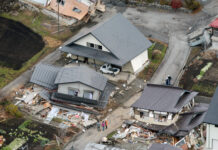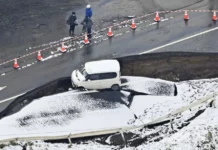India leading the fight against climate change
AROONIM BHUYAN
India Post News Service
NEW DELHI: Danny Faure, President of the Indian Ocean archipelago nation of Seychelles, made the whole world sit up and take notice last month when he made an appeal for the protection of the world’s oceans sitting in a submersible deep underwater.
Speaking to an audience of over 110 million viewers in over 40 countries, the address from the submersible was an opportunity for President Faure to highlight the importance of concrete actions for ocean conservation.
Describing the ocean as ‘the beating blue heart of our planet’, the President said in his speech, “At this depth, I can see not only the incredible beauty of our ocean, but the care that it urgently needs to stay this way. This is a historical moment for my country, Seychelles. Together with Nekton and a unique collaboration of over 40 partners combining marine research and state-of-the-art technology, today I have this opportunity to be in a submersible 124 metres below the water surface.”
Speaking to the press after his submersible dive, the President described the unique experience as “so,so cool”, and said that it has made him an even stronger advocate of ocean conservation and taking concrete actions to mitigate against climate change.
In the first-ever live speech from a submersible, 124 meters under the surface of the ocean, the President said, “Over the years, we have created these problems. We can solve them. We must solve them. We need decisive, coordinated international action.
“The deep ocean is the beating heart of the planet, yet we have better maps of planet Mars than we do of the ocean floor. This needs to change, as we gather the information available to identify priority areas for protection.
“This issue is bigger than all of us, and we cannot wait for the next generation to solve it. We are running out of excuses to not take action, and running out of time.”
Faure’s speech brought memories of the 2009 meeting held underwater by Mohammed Nasheed, the former President of another Indian Ocean atoll nation Maldives.
Donning scuba gear and using hand signals,Nasheed and 13 other government officials staged the meeting 20 feet below the surface of a lagoon off Girifushi, an island usually used for military training,to highlight the threat of global warming to the lowest-lying nation on earth.
With a backdrop of coral, the meeting was a bid to draw attention to fears that rising sea levels caused by the melting of polar ice caps could swamp this Indian Ocean archipelago within a century. Its islands average seven feet above sea level.
“What we are trying to make people realize is that the Maldives is a frontline state. This is not merely an issue for the Maldives but for the world,” Nasheed said.
As bubbles floated up from their face masks, the President, Vice President, Cabinet Secretary and 11 Ministers signed a document calling on all countries to cut their carbon dioxide emissions.
The Seychelles and Maldives are small nations but have managed to the dangers of climate change to global focus through the actions of their leaders.
India is among the large nations that are leading the fight against climate change. After the NDA government came to power in 2014, Prime Minister Narendra Modi took personal interest in the world’s actions against this phenomenon threatening humanity.
India played a critical role in the signing of the Paris Climate Agreement in 2015.The Agreement builds for the first time brings all nations into a common cause to undertake ambitious efforts to combat climate change and adapt to its effects, with enhanced support to assist developing countries to do so. As such, it charts a new course in the global climate effort.
The Paris Agreement’s central aim is to strengthen the global response to the threat of climate change by keeping a global temperature rise this century well below 2 degrees Celsius above pre-industrial levels and to pursue efforts to limit the temperature increase even further to 1.5 degrees Celsius. Additionally, the agreement aims to strengthen the ability of countries to deal with the impacts of climate change. To reach these ambitious goals, appropriate financial flows, a new technology framework and an enhanced capacity building framework will be put in place, thus supporting action by developing countries and the most vulnerable countries, in line with their own national objectives. The Agreement also provides for enhanced transparency of action and support through a more robust transparency framework.
The Paris Agreement requires all parties to put forward their best efforts through intended nationally determined contributions (INDCs) and to strengthen these efforts in the years ahead. This includes requirements that all parties report regularly on their emissions and on their implementation efforts.
Following the Paris Agreement, India submitted its NDCs to the United Nations Framework Convention on Climate Change (UNFCCC).
Following are the salient features of India’s INDCs:
- To put forward and further propagate a healthy and sustainable way of living based on traditions and values of conservation and moderation.
- To adopt a climate-friendly and a cleaner path than the one followed hitherto by others at corresponding level of economic development.
- To reduce the emissions intensity of its GDP by 33 to 35 per cent by 2030 from 2005 level.
- To achieve about 40 per cent cumulative electric power installed capacity from non-fossil fuel-based energy resources by 2030, with the help of transfer of technology and low cost international finance, including from Green Climate Fund.
- To create an additional carbon sink of 2.5 to 3 billion tonnes of CO2 equivalent through additional forest and tree cover by 2030.
- To better adapt to climate change by enhancing investments in development programmes in sectors vulnerable to climate change, particularly agriculture, water resources, Himalayan region, coastal regions, health and disaster management.
- To mobilize domestic and new and additional funds from developed countries to implement the above mitigation and adaptation actions in view of the resource required and the resource gap.
- To build capacities, create domestic framework and international architecture for quick diffusion of cutting-edge climate technology in India and for joint collaborative R&D for such future technologies.
India’s INDCs center around the country’s policies and programs for sustainable lifestyles, cleaner economic development, reducing emissionintensity ofGDP,increasingtheshareof non-fossil fuel-based electricity, enhancing carbon sink, adapting to climate change by enhancing investments in development programs in sectors vulnerable to climate change, particularly agriculture, water resources, Himalayan region, coastal regions, health and disaster management, mobilizing domestic and new and additional funds from developed countries to implement such mitigation and adaptation actions in view of the resource required and the resource gap and technology transfer and capacity building.
India’s INDCs are unique in the sense that, of the eight missions outlined in its National Action Plan on Climate Change, four efforts are focused on adaptation efforts –sustainable agriculture, increasing water use efficiency, sustaining the Himalayan ecosystem and creating sustainable habitats.







